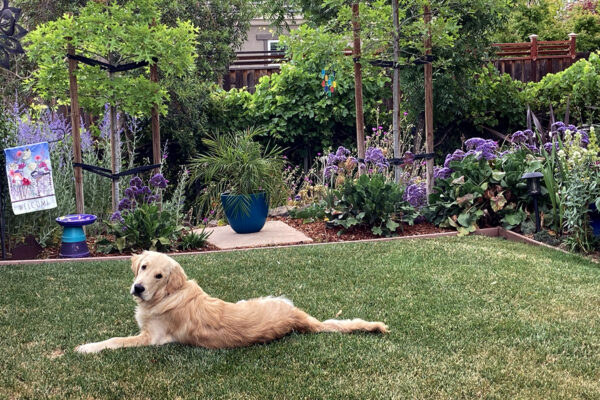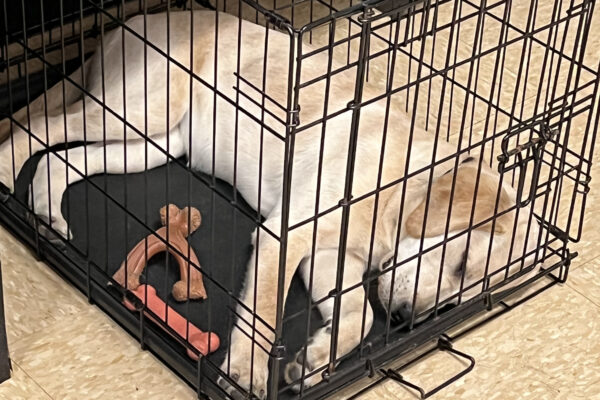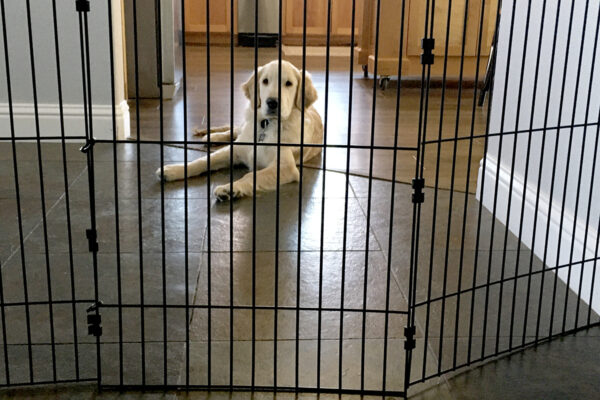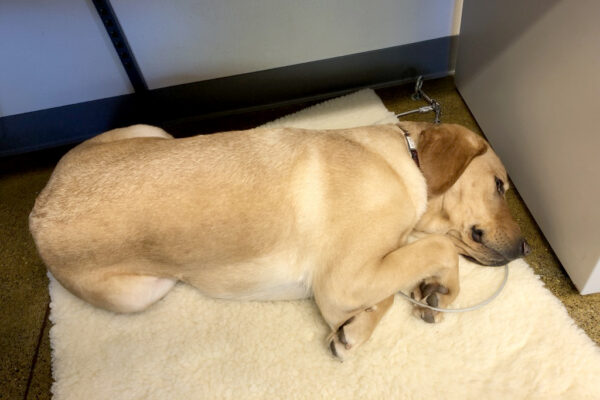Confinement
Minimum Requirements for Fencing, Kennel Runs, Crates, X-Pens, and Tie-Downs
Puppies cannot be left confined alone at home all day while the raiser is at work or school, regardless of the method used. Follow these guidelines for the maximum amount of time puppies should be left unattended. Note: additional safety guidelines are required for Female Dogs in Season.
Outdoor Fencing and Kennel Runs for Unsupervised Puppies

- Yard fences should be a minimum of five feet in height and secure enough to prevent escape.
- “Invisible” or electronic fences are prohibited and are not considered secure.
- Female puppies that are in season may only be left in a kennel run approved by the puppy raising field manager (PFM) specifically for in-season females.
- All doors/gates should be secure to prevent the puppy from accidentally opening the latch.
- Puppies may not be left outside unsupervised in temperatures over 80 degrees or below 50 degrees (including wind chill), and the relative humidity should range from 30 to 70%.
- Shade, a warm, dry protected area, and drinking water should always be available.
- No fence-to-fence or direct access to other dogs who exhibit undesirable behaviors (e.g., barking, digging, fence fighting).
- No access to any swimming pool or bodies of water.
Reference: American Veterinary Medical Association | Companion Animal Care Guidelines
If the fence is not fully secure, or the puppy is not reliable loose in the yard, consider using a kennel run. Kennel runs must meet the following requirements:
- At least six feet wide, twelve feet long, and six feet high (preferably covered).
- Clean and dry with suitable flooring if the puppy may dig.
- Rubber horse stall mats or large cement stepping stones placed side by side make an inexpensive, puppy-proof, non-permanent kennel floor.
If you have questions about yard safety or setting up a kennel run, ask your club leader or PFM. They are here to help!
The Crate

- Crates must be large enough for a puppy to stand up, lie down, and turn around in it. Think of this space as a cozy, happy den for the puppy.
- Comfortable bedding should be provided unless the puppy has lost this allowance due to unsafe behavior following the guidelines for Maximizing Puppy Wellbeing and Safety.
- Regardless of age, puppies should not be left in a crate for more than four hours maximum other than overnight.
The Play Yard, X-Pen, and other Barriers (baby gates, etc.)

- X-pens and other barriers should be secured to prevent collapse if the puppy may jump up or push on the panels.
- Heavy duty play yards with joints locked into shape are generally secure enough to stand alone.
- Traditional x-pens can be secured to a wall by bungee cords, straps attached to eyebolts, or other means.
- Puppies who attempt to escape the area should only be confined with barriers at least 36 inches tall until they have learned to settle without attempting to escape.
- Puppies may only be left unattended in a pen or other space blocked with barriers after earning this allowance and demonstrating safe behavior following the guidelines for Maximizing Puppy Wellbeing and Safety.
- Regardless of age, puppies should not be left confined using an x-pen or other barriers for more than four hours maximum other than overnight.
The Tie-Down (Tethering)

- Tie-downs should be at least 30 inches in length, and long enough to permit movement. Your puppy should be able to stand and turn around comfortably.
- Puppies who attempt to lunge or run to the end repeatedly should not be tethered using a tie-down longer than 36 inches to prevent tangling or injury.
- Only secure tie-down spots should be used if the puppy may pull on the tether.
- Consider mounting eyebolts to the wall or using heavy furniture (couch, table, bed, etc.).
- You may want to identify several secure places in the home for tie-down locations.
- Only use a heavy-duty tether (like your cable tie-down) if the puppy may chew on the tie-down.
- Puppies may only be left unattended on tie-down after earning this allowance and demonstrating safe behavior following the guidelines for Maximizing Puppy Wellbeing and Safety.
- Regardless of age, puppies should not be left tethered using a tie-down for more than four hours maximum other than overnight.
Guide Dogs for the Blind Puppy Raising Guidebook, all rights reserved. Please see our Terms of Use Guidelines to utilize the contents within.
